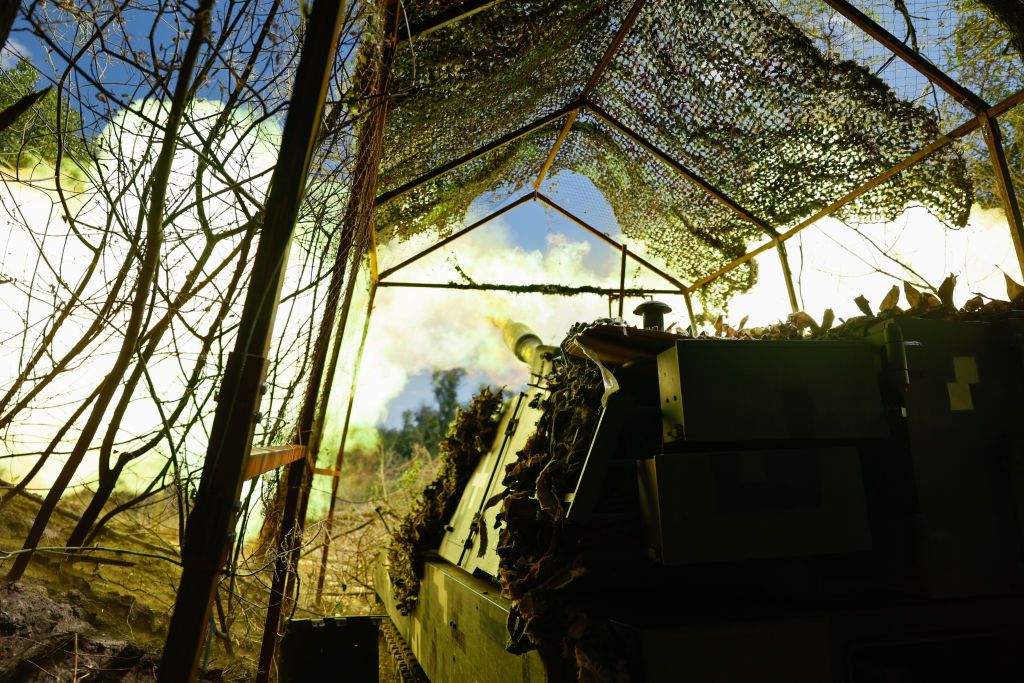la ofensiva está atascada, ahora hilo para anticipar "contraofensivas".
@lowfour (post #1292)
habrá que ir buscando iconito para madmax fury road, porque esto ya no tiene otra explicación
@elarquitecto (post #1293)
Si te fijas es otro ángulo aún más cinematográfico del ataque que pusimos hace una semana o así, que había como nieve o escarcha y los tanques iban en fila india.
Pero en Vuledahr si que hay videos nuevos... De donde coño sacan tantos tanques y blindados! Te imaginas esas pérdidas de Tanques de Alemania o yo que se?
Eso si, se los han cepillado TODOS. Estamos hablando de miles y miles de blindados... y aún tienen para hacer estas locuras y palmar 200 o 300 en un par de semanas.
Si antes saco el tema, antes encuentro un artículo que analiza la HECATOME RUSKYI pero SIN contabilizar los JRANDES HEZXITOS RUSOS de los últimos días.
French Researchers Predict That by 2024 There May Be 1,500 to 250 Tanks Left in russian Army
The French research institution Institute Action Resilience (IAR, or The Action Resilience Institute in English) has published its own assessment of the current state of the armored park of the russian army as well as the ability of the russians to manufacture new, repair old and modernize existing tanks for their troops
The main result of this study is the conclusion that by the beginning of 2024, in the framework of three different scenarios, an estimated 1,500 to 600-400 or even 250 tanks of all types, from the T-62 to the T-90M, may remain in the ranks of the russian army. This, in turn, will affect the course of russia's full-scale war against Ukraine. Such an assessment looks excessively and unexpectedly optimistic, so it is worth analyzing in more detail the thoughts of the experts of the French Institute Action Resilience.
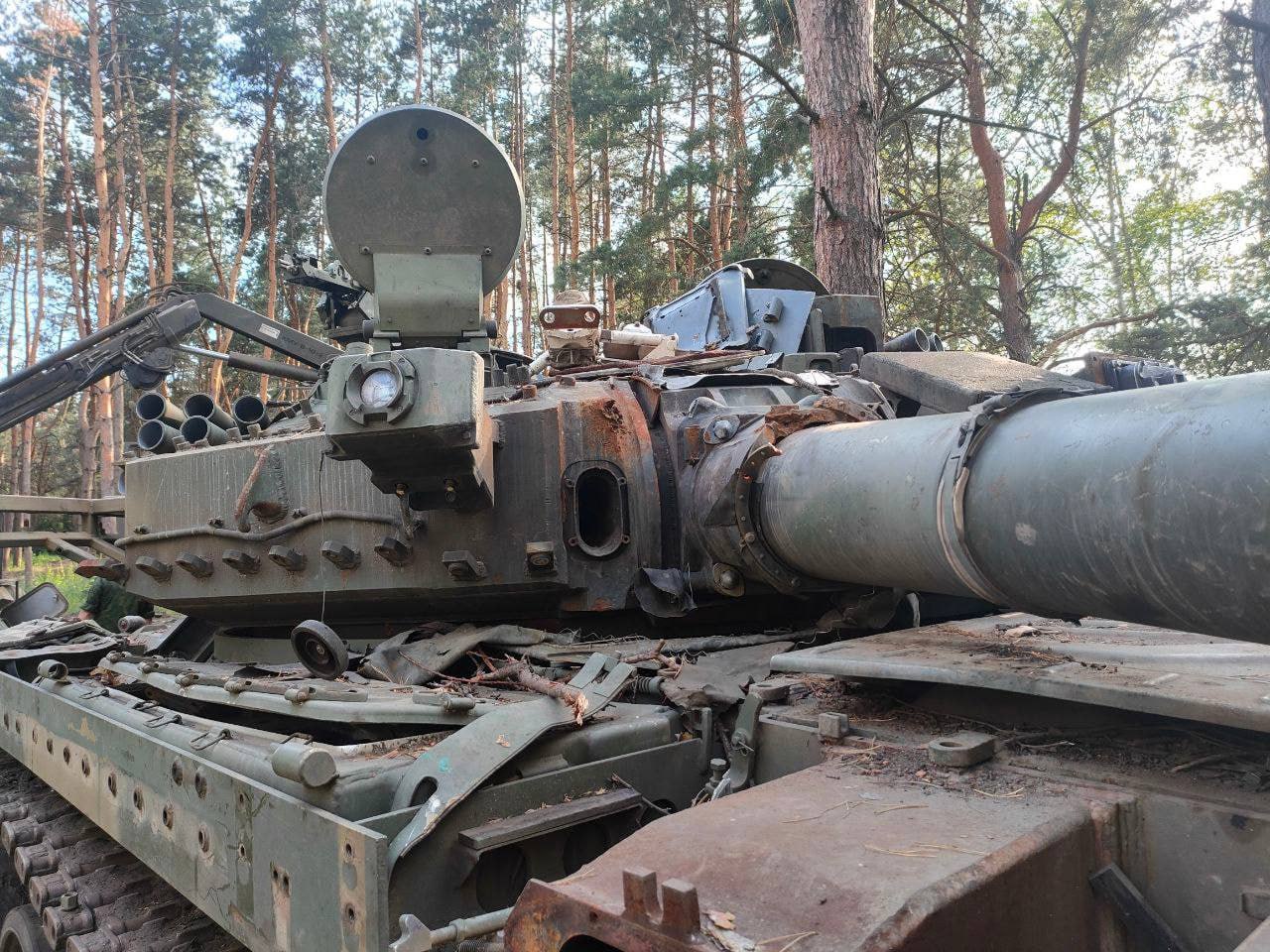
Damaged T-90M "Proryv" of the russian army, which became a "donor of spare parts", July 2023 / Photo: Naalsio twitter profile
In their assumptions, IAR experts proceed from the following. In their opinion, satellite images indicate that at this time only approximately 3.1 thousand tanks of all types can remain at the storage bases of the russian army, in particular: more than 1,000 T-72 tanks, more than 700 T-62 tanks, more than 600 T-80 tanks, about 250 T-55 tanks and about 330 more vehicles, the type of which the French could not identify on satellite images.
IAR researchers also took into account the Russians' statements that during the full-scale war against Ukraine, they increased the production of new tanks and the repair and modernization of existing tanks to 700-800 vehicles per year. Also, the French researchers took into account that here the russians could resort to prescriptions and write down in the "repair" category all the work that could be performed even in field conditions. Therefore, according to the French, the real capabilities of the russians here look like this: 10 new tanks, 205 modernized and 90-180 restored in just one year.
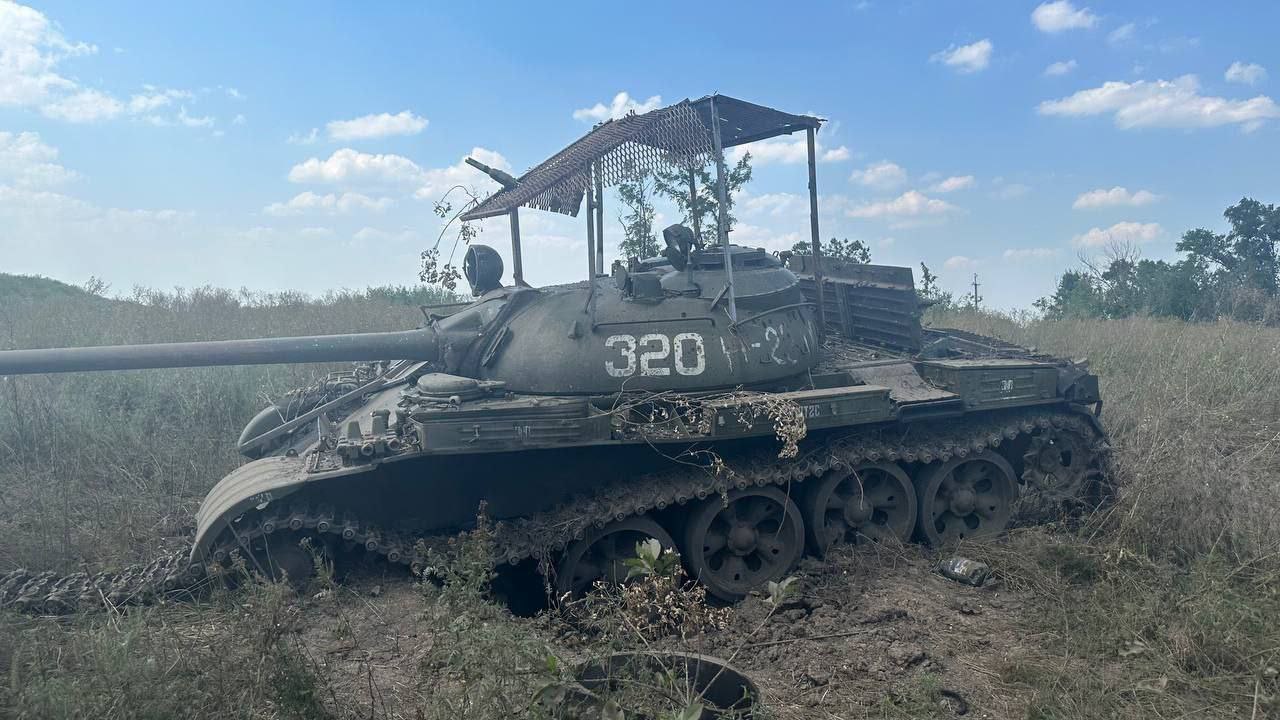
russian T-55 shot down by the warrios of the Armed Forces of Ukraine, summer of 2023 / Source: Telegram channel NMFTE
It was with such initial data that the experts of the French IAR undertook to simulate three scenarios for the armored fleet of the russian army, depending on the rate of losses on the battlefield:
The first scenario - optimistic. Thanks to the success of the counteroffensive of the Armed Forces of Ukraine, it is possible to increase the rate of losses of the Russians to an average of 12 vehicles per day against the current 2.62 vehicles per day. The level of natural wear and tear of russian tanks is also superimposed on this. It is within the framework of this scenario that by the beginning of 2024, only 250 tanks may remain in the Russian army, while this will be a "collectible hodgepodge" of archaic T-62M and new T-90M tanks. Under such conditions, the armored units of the russian army cease to be a significant factor in hostilities against Ukraine.
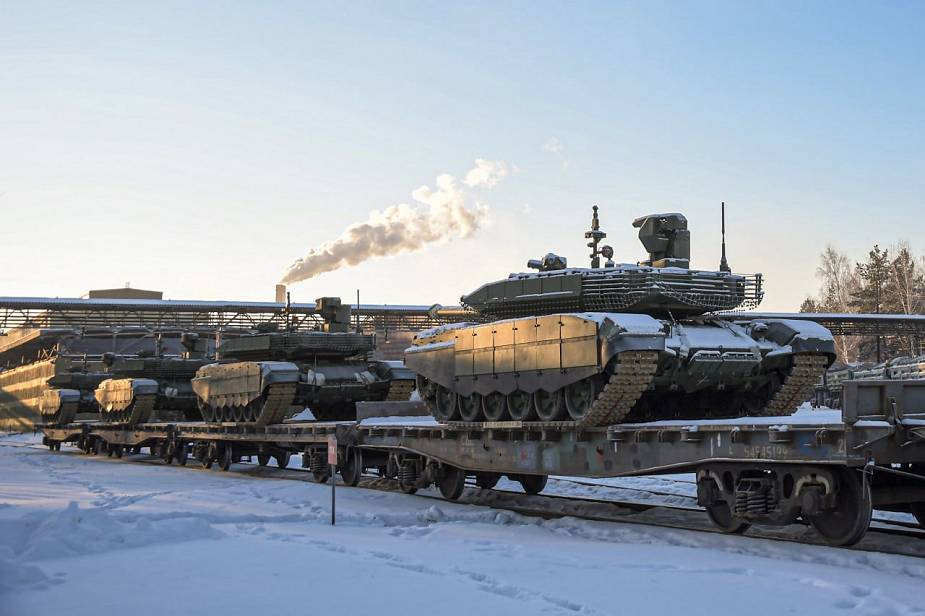
Echelon of new russian tanks T-90M "Proryv", January 2023 / Open source photo
The second scenario - weighted average. The Armed Forces of Ukraine are approaching a slightly lower rate of disposal of russian tanks per day on average, and by the beginning of 2024, the russian army should have from 400 to 600 tanks of all types, from T-62M to T-90M. This will be enough for the occupiers only to have a combat-ready tank brigade in all important directions of the front.
The third scenario - pessimistic, or "stagnant" one, in which the russians manage to maintain an acceptable pace of tank fleet renewal, and the Armed Forces of Ukraine fail to cross the average barrier of 2.62 destroyed tanks per day. In such conditions, the russian army will even be able to maintain one combat-ready tank army, which will be capable of conducting coordinated offensive actions.
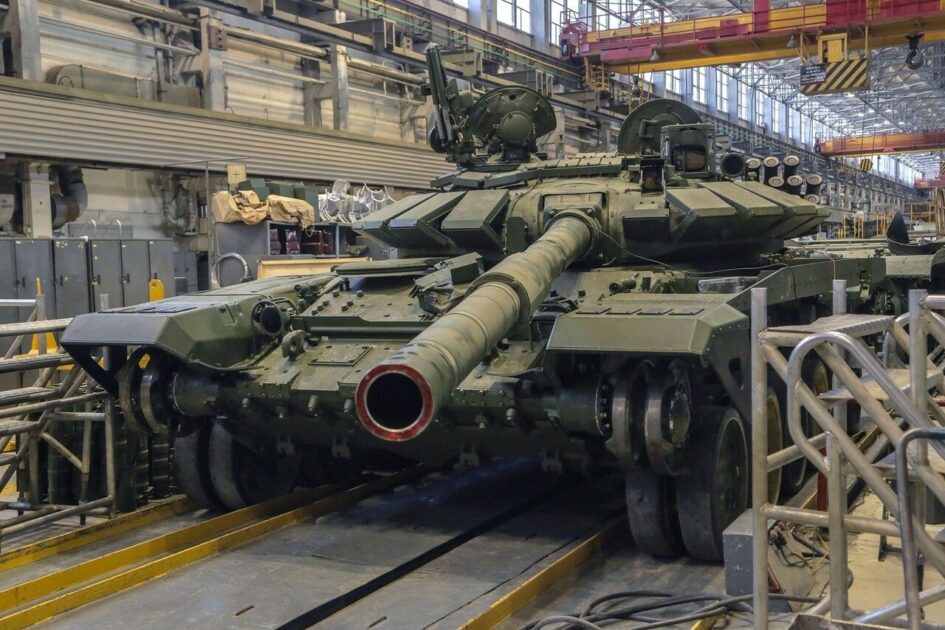
The T-72B3 tank in the Uralvagonzavod workshop / Illustrative photo of pre-war times
It should be noted that even the implementation of the pessimistic scenario suggests a reduction in the potential of the aggressor state in terms of the number of available tanks by 25%, which is already a high indicator that could hardly have been predicted not so long ago...
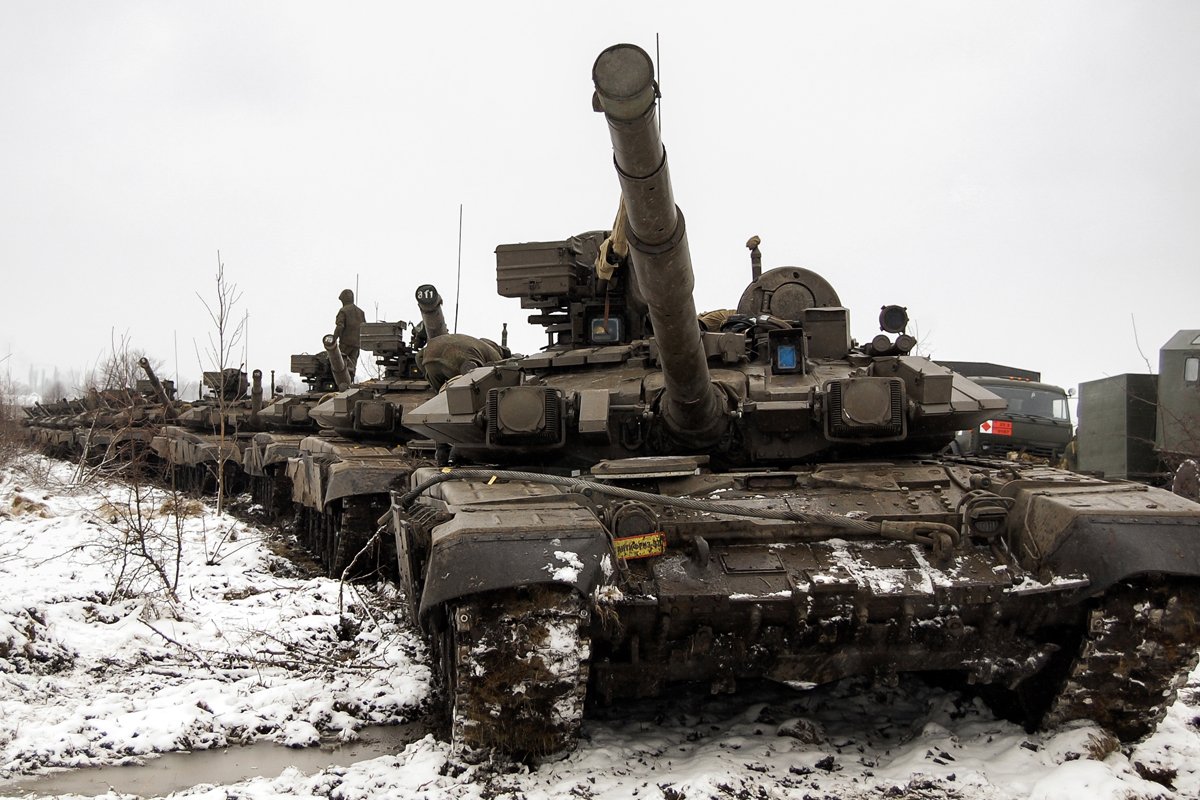
T-90 during exercises of the Russian army, December 2018, Open source illustrative photo
Ayer 5 tanques
El 6 nov: 4 tanques
5 nov: 8 tanques
2nov: 18 tanques
30 oct: 15 tanques
26 oct: 29 tanques
25 oct: 7 tanques
22 oct: 18 tanques
20 oct: 55 tanques
16 oct: 17 tanques
15 oct: 8 tanques
14 oct: 9 tanques
13 oct: 26 tanques
12 oct: 42 tanques
11 oct: 34 tanques
04 oct: 13 tanques
2 oct: 15 tanques
27 sept: 3 tanques
17 sept: 4 tanques
MADRE MIA si esto no es estar en el escenario optimista ese yo ya no se.
Solo esos días contabilizados (no se si es que faltan días o los juntan) van 325 tanques destruidos.
Si mantienen una media de 8 tanques al día estamos claramente cerca del escenario optimista. Es decir, les quedarían 250 tanques a los rusos a principios de 2024 en unas 7 semanas.
@lowfour (post #1295)
pues igual están trincando tanques de best-corea y por ahí, no??
menudo desguace lo de ucrania, esto no está pagao, eh?
lo que decías de las nacioncitas en el otro hilo, con suerte vemos a los putiners despeñaos y tal... al menos estos sí
Ojo que este vídeo si que da para paja, a diferencia de los fachas medio mongolos haciendo su mayo del 68.
Al loro la precisión de los Storm Shadows o la versión francesa. ES ACOJONANTE. Nosecuantos kilómetros de trayectoria e impactan los tres en un barco???
PERO ESTO QUE EEEEEESSSS
Como saque USA la Wunderwaffen los rusos se iban a cagar pero bien.
@lowfour (post #1298)
me acabo de quedar con el culo torcio
esto sí que son gamechangers... y que las defensas AA son un mojón, claro
@elarquitecto (post #1299)
No no, es que lo explica este vídeo muy bien (por fin ha vuelto, ha estado missing más de dos semanas, pensaba que le echaron novichok en el colacao, probablemente solo COVIC). Lanzaron misiles storm shadow y tal... los rusos mandaron cazas a interceptarlos.. pero en ese momento desde el otro lado los ukros lanzaron misiles neptune y los cazas los priorizaron... dejando que volaran el barco.
Minuto 3 mas o menos
Parece que los Ukros están volando sistemas de guerra electrónica capaces de interferir la señales GPS en un radio de 20 a 60 kilómetros.
Y lo han hecho con... misiles guiados por GPS.
Es obvio que USA está A SACO ahí en la guerra contra Rusia porque están mapeando y aprendiendo TODO sobre el armamento Ruso, Coreano y probablemente Chino. No les interesa llegar y arrasarles, les interesa desgastarles y ver qué se sacan de la manga.
Recordáis que los rusos hicieron algo que afectó a los Himars? Pues nada, como si eso no existiera ya. Los Himars siguen haciendo coladores a partir de tanques y mobnicks.
Lo mismo con los S400 y los S300. Se los pasan por el forro.
Y los patriots interceptando misiles hipersónicos qué?
Por eso USA ha decidido montar industria armamentística en Ucrania, les van a poner las fábricas ahí porque el Know How que tienen los Ukros ahora no tiene igual. Know how de usar armas occidentales en combates brutales a gran escala contra Rusia.
Lo próximo que vamos a ver (que ya hay prototipos) son sistemas móviles antidrones. Es que los Lancet si que les han reventado bastante a los Ukros, de hecho recordáis que los drones homemade ukros no hacían gran cosa antes a los blindados. Y luego llegaron los Lancet y reventaban que daba gusto. Ahora vemos que los nuevos drones Ukros si que son más que capaces de inhabilitar blindados y reventarlos.
Luego llegarán los israelís o los chinos con enjambres de drones autónomos y se lió el Terminator.
Por cierto que los usanos tienen drones AI autónomos pero los militares no los quieren porque no se fían. O eso leí.
Lo que tenían que hacer es poner una fábrica de HIMARS en Polonia o algo y empezar a fabricar como si no hubiera mañana, eso si que es un gamechanger brutal.
Y ojo que los rusos han hecho acopio de 900 misiles de crucero, van a ser navidades MUY complicadas en Kyiv. A pesar de los nuevos sistemas antiaéreos que les han mandado.
Otra y os dejo en paz... el barquito de marras era importante porque podía lanzar 8 misiles khinzal.
@lowfour (post #1300)
ostia, les van a hacer aparcar los helicopteros en siberia, pero de verdad!!
y menudo movidon lo del barco ese, entre señuelos y tal... pero claro, es que no solo era zumbarse el barco, sino los misiles de al campañita de invierno que los amigos de cinta están preparando... como el año pasado, joder centrales y tal
@lowfour (post #1303)
sisi, 900 dicen que tienen... yo solo espero que los ukr tengan un iron dome como en israel o algo así, o mejor, porque los rusos lanzaran oleadas de 100 o incluso 200 para que colar los máximos posibles
Les acaban de llegar estos NASAMS noruegos.
https://en.wikipedia.org/wiki/NASAMS
NASAMS (Norwegian Advanced Surface-to-Air Missile System, also known as the National Advanced Surface-to-Air Missile System[5]) is a distributed and networked short- to medium-range[6]: 4 ground-based air defense system developed by Kongsberg Defence & Aerospace (KDA) and Raytheon.[7] The system defends against unmanned aerial vehicles (UAVs), helicopters, cruise missiles, unmanned combat aerial vehicles (UCAVs), and fixed wing aircraft,[6]: 11 firing any of a wide range of existing missiles.
NASAMS was the first application of a surface-launched AIM-120 AMRAAM (Advanced Medium Range Air-to-Air Missile). NASAMS 2 is an upgraded version of the system capable of using Link 16, which has been operational since 2007. As of 2022, NASAMS 3 is the latest upgrade. Deployed in 2019, it adds capability to fire AIM-9X Sidewinder, IRIS-T SLS and AMRAAM-ER missiles, and introduces mobile air-liftable launchers. NASAMS has proven interoperability with longer range systems such as Patriot.[8]
>The NASAMS system, which has a maximum range of 50 kilometers depending on the model used, is particularly valuable for Ukraine as it uses the AIM-120 AMRAAM interceptor missile, which is the same missile used in air-to-air function in Western fighter jets.
Si antes hablo de los Lancet
https://kyivindependent.com/how-russias-homegrown-lancet-drone-became-so-feared-in-ukraine/
How Russia’s homegrown Lancet drone became so feared in Ukraine
In the bubble of pro-Ukraine communities on the Internet, the constant inflow of battlefield videos showing the destruction of Russian equipment regularly lifts the moods of hundreds of thousands of supporters of Ukraine’s struggle around the world.
Wander over to the Russian side of the internet, whether it’s state media or the murky world of milblogger Telegram channels, and the situation is quite the opposite. Spending time here, seeing video after video of destroyed expensive Western equipment is a sobering reminder that this war goes both ways, and the enemy is not sitting idle.
In many of the Russian videos, there is one culprit that stands out, responsible for dozens of confirmed hits on Ukrainian equipment: the Lancet kamikaze drone, manufactured by ZALA Aero Group, a subsidiary of Russian arms giant Kalashnikov Concern.
Since it started being used in larger numbers on the battlefield in late 2022, the Lancet has gained a reputation as Russia’s most effective weapon against the higher-value targets, often located dozens of kilometers behind the zero line.
Open-source lists of Ukrainian equipment destroyed by the drones make for grim reading for supporters of Ukraine.
Targets eliminated by Lancets include everything from Leopard tanks, dozens of Western howitzers, S-300 air defense launchers and radars, and more.

A screenshot from a Russian reconnaissance drone purportedly showing a Lancet suicide drone destroying a Ukrainian Su-25 combat jet at an airfield near Kryvyi Rih, Dnipropetrovsk Oblast, in October 2023. (Voenkor Rudenko/Telegram)
In a particularly painful pair of strikes in autumn this year, two Ukrainian combat jets, one MiG-29 and one Su-25 a few weeks later, were destroyed by Lancets at Dovhyntseve airbase near Kryvyi Rih, around 65 kiometers from the nearest Russian-controlled territory.
The strikes showed not only the increasing range capabilities of the drones, but Ukraine’s struggle to better protect such priceless targets.
Ukrainian officials have been open about the danger posed by Lancet.
In his Nov. 1 essay published by the Economist on the technological challenges in the current state of positional warfare, Ukrainian Commander-in-Chief Valerii Zaluzhnyi made special mention of the Lancets, which, when aiming for targets illuminated by other Russian reconnaissance drones, create a challenge “countering which is quite difficult.”
"The Russians have a specific model which addresses a lot of requirements in battle and that's a relatively capable system that keeps getting improved,” robotics and UAV expert Samuel Bendett told the Kyiv Independent, "which is why the Ukrainians are now publicly saying that it's dangerous."
Seeing the success of this relatively new type of weapon, Moscow is now looking to take Lancet a step further, with a mysterious new Lancet-type drone claimed to be able to fly in swarms and find and engage targets autonomously. (Mira, justo lo que decía yo)
What is a Lancet?
The Lancet was first unveiled by ZALA at a military expo in Moscow in 2019, just before loitering munitions really started to make a name for themselves on the battlefield.
Two models were revealed straight away, the larger Lancet-3, with a stated maximum payload of three kilograms, and the smaller, foldable Lancet-1, with a one-kilogram payload. Closer to that of larger FPV (first-person view) drones, even the smaller payload is perfectly capable of disabling and destroying large pieces of military equipment with a precise-enough hit.
Both models feature a distinct double X-wing design, which some commentators have pointed out to be strikingly similar to the Israeli-built UVision Hero family of drones developed along a similar timeline.
Just a year later, the devastating effect of this new type of weapon against an unprepared enemy was demonstrated in the 2020 Nagorno-Karabakh war, where defending Armenian forces were largely helpless against Azerbaijan’s use of Israeli Harop and Harpy loitering munitions.
“The Nagorno-Karabakh war confirmed the utility of these drones,” said Bendett, “as well as Russia's own experience in Syria, where it found out such appalling munitions can actually be quite effective.”
For a weapon that has tormented Ukrainian forces so much, the Lancets’ work is deceptively simple. Targets are found by Russia’s equally-competent line-up of longer-range reconnaissance drones such as the Orlan-10 and SuperCam, after which a Lancet is launched from a special purpose-built catapult to fly at a stated top speed of around 300 kilometers per hour.
A video posted on Russian Telegram channels showing a Russian Lancet kamikaze drone striking a Ukrainian Leopard 2 tank in Zaporizhzhia Oblast in July 2023. (Astrahandm/Telegram)
Just as with Russian long-range missiles, the on-board electronics in Lancet drones are powered by Western-built microchips, which continue to flow into Russia through third-party countries despite sanctions. One shot-down Lancet displayed by Ukrainian authorities in March 2023 was seen to contain silicon made by U.S.-based semiconductor firms NVIDIA and Xilinx.
So-called kamikaze drones come in all shapes and sizes, from small, dirt-cheap FPV quadcopters with a usual range of around seven kilometers, to the long-range but slow Iranian Shahed-type drones which Russia uses to target civilian infrastructure all over Ukraine.
The Lancet fills an important gap for mid-range precision strikes and counter-battery fire, which Russia, lacking a system like the U.S.-built HIMARS, has otherwise struggled with in Ukraine due to the lower range and precision of their tubed and rocket artillery.
“Even when our equipment is hidden in the bushes, it (Lancet) sees the silhouette from far away, and just dives at it like a falcon,” said Oleksandr “Hollywood,” an air defense specialist in Ukraine’s 47th Mechanized Brigade, to the Kyiv Independent.
Battlefield dilemma
Seeing their effectiveness on the battlefield, Moscow quickly moved to greatly increase the scale of production of Lancets.
A television report released on state channel Rossiya-1 in July 2023 claimed that Russia has already upscaled its production of the drones, repurposing shopping center space abandoned by Western companies, including one in ZALA’s home city of Izhevsk that was shown in the report.
The footage of the Lancet factory sparked a widespread reaction from Ukrainians on social media, with many raising the alarm about the danger of underestimating Russia’s capacity for both innovation and production scale in its military-industrial complex.
Just as with its other drones and equipment, the hardware and the software on the Lancet has also been constantly modified by ZALA to fly ever further and more accurately, as the strikes on the Ukrainian jets showed.
“There's obviously a lot of feedback from the front and there's a lot of pressure on domestic drone developers to actually manufacture the UAVs most needed,” said Bendett.
“Those two factors combine to create conditions where there's a lot of testing and evaluation that's taking place.”
Lacking any obvious counter to the Lancet, Ukrainian forces have scrambled to defend their targets with a mixed bag of countermeasures.
With their small physical size and low heat signature, the drones are very difficult to detect for traditional air defense radars, and their low cost makes using a guided anti-air missile against them unsustainable, just like with Shahed-type drones.
Often, the responsibility to at least attempt to shoot down a Lancet falls upon field air defense crews manning Soviet-era ZU-23 anti-air autocannons. Although Ukrainian crews manning this system do occasionally report successful hits on Lancets in interviews with media, the drone’s small profile and difficulty to hear and detect means that such triumphs are rare.
“We had a case in the brigade when someone shot one down with an AK (rifle), but that was a complete fluke,” said Oleksandr.
Another option is electronic warfare (EW). Although larger fixed-wing drones like the Lancet are usually constructed to be much more resistant to enemy EW than a quadcopter, both Ukraine and Russia are racing to deploy more and more powerful EW systems on the battlefield.
On Nov. 3, former Ukrainian President Petro Poroshenko announced a Hr 150 million ($4.2 million) crowdfunding campaign for the manufacturing of a new model of powerful EW station that claims to be able to hamper the work of Lancets.
“This EW can shut down Russian UAVs at a distance of up to 20 kilometers, blind Zala and Orlan so that they can no longer adjust their Lancets to our positions,” Poroshenko’s post read.
When all else fails, Ukrainian artillery crews have often taken to erecting wire netting around their howitzers to protect them from Lancet strikes. Crude as they are, this last resort is often the most effective defense: even if the net fails to ensnare the drone without it detonating, a warhead triggered by the net is unlikely to cause significant damage compared to a direct hit.
“No single countermeasure can be effective 100%,” said Bendett. “So when they work together, that's when they can be most effective.”
Frightening future
As effective as the current-model Lancets are, Russia claims to be working on a new version of the drone that could not only present a new threat to Ukraine, but could completely change the future of warfare in the 21st century.
On Oct. 21, Russian Telegram channels reported the first alleged use of “Izdelie-53,” a new model of the Lancet with a unique single pinwheel X-wing design that can be stored and transported in collapsed form in tubes, which also allegedly serve as launchers.
The video posted shows the point of view of a loitering munition, purportedly an Izdelie-53 type drone, diving down at a Czech-made Vampire multiple rocket launcher. On the screen, a box marks the Vampire in its sights and the Russian text reading “Target locked” appears, implying that the target was found and engaged autonomously.

A screenshot from a video posted to Russian Telegram on Oct. 21, 2023 purporting to show the use of a Lancet-type drone with autonomous target locking capabilities. (Kubanskie Artilleristy/Telegram)
Izdelie-53 was first announced in July this year, in the same tour of ZALA’s Lancet shopping center on Rossiya-1. The drones are shown folded up in their tubes, and apart from a suspiciously blurry shot of a launch, their flight is only shown in an animated graphic.
The deployment of autonomous or near-autonomous technology for military purposes has long been a popular topic of discussion in the realms both of serious military analysis and in science fiction. With the rapid worldwide development of artificial intelligence (AI) and the increased availability of drones for non-state actors and terrorist groups, the conversation has taken on a new urgency.
In Western countries, discussion of future autonomous lethal weapons comes with serious ethical challenges, with the common consensus that a human operator should always be involved in the final decision to engage a target.
According to ZALA Aero’s chief constructor Aleksandr Zakharov, Russia has had no such qualms when developing Izdelie-53.
“We have already conducted battlefield tests (of Izdelie-53) in fully autonomous mode, without the involvement of humans,” he said in the Rossiya-1 report.

A screenshot of an computer-animated video by Zala Aero visualizing the deployment of Izdelie-53 drones in swarm mode. (Zala Aero)_
On top of their autonomous targeting capabilities, these new drones are also claimed to be able to fly in swarms of up to several dozen at once.
According to claims made by ZALA Aero, the drones in the swarm will communicate with each other autonomously through “neural networks,” enabling them to locate, prioritize, and engage multiple targets on their own, overwhelming local air defenses that already face problems dealing with a single Lancet.
Whether or not they operate autonomously, the use of coordinated swarms of drones is the natural next step in the global drone arms race, and a major concern for Ukraine, which could struggle even more to defend its higher-value targets in the rear.
For now, there has been no independent verification of the use of Izdelie-53 either in the strike on the Vampire nor anywhere else in Ukraine.
In an interview to RBC-Ukraine on Nov. 3, Ukrainian military intelligence spokesperson Andrii Yusov said that there was no evidence of the mass use of Izdelie-53 on the battlefield, and that the claims made about the drones in Russian media can not be verified.
“Nevertheless, we can say that modified, improved Lancets are used by the aggressor,” he added, “and this is always an additional risk factor.”
Juuusto lo que decía en mi post.
Y esto dice uno que explicaría por qué USA no tiene nada parecido:
>Because in NATO terms, these things suck.
>
That isn't to dissuade what they're doing in Ukraine, where they objectively do not suck, but it must always be remembered, this is not how a NATO war goes. A 40km+ long single attack munition thats this slow, relatively weak and needs a ground set up is virtually worthless to NATO forces who would just drop a Paveway, Brimstone, JDAM, GMLRS or guided 155mm of hot metal on the target and move on.
>
>It's just not what NATO needs in its war, and not what it fears from an enemy because Lancet is a long term attrition weapon for frozen conflicts.
>
>Perfect for Russia. Would be good for Ukraine too, but it's just not in NATO's armoury because this war is not how NATO fights.
>
>Switchblade 600 is a closish thing, but that was on a very limited production with no assurance it'd ever see mass production until this war started.
>
>As a result, no existing production line for it. What Ukraine got was things like GMLRS, which is wholly superior in every single war. If someone builds one up, it could be useful, but most countries prefer to focus on the better kit for Ukraine.
@lowfour (post #1310)
ostia, qué curioso!
como la otan no se mete en guerras de trincheras, para qué cojones quiere drones suicidas y tal, no?? que los tiene o los contempla o algo, pero en plan, bueno... ya si eso el año que viene...
porque claro, la otan, cuando te pega, te pega, no se anda destruyendo tanquecitos o camiones o 3 en una trinchera, le cortas la cabeza a la serpiente y ya
@elarquitecto (post #1311)
Eso parece. Pero también fue que los famosos Switchblade fueron una patraña.
Los primeros Switchblade 300, para matar a una persona, tenían más o menos una granada de carga. Ahora tienen 1'5kg o así. Y los Switchblade 600, más parecidos a los Lancet, no estaban ni en producción porque no había contrato, de modo que no había una línea de montaje.
Es curioso lo de los rusos. Menudo capital humano y recursos tienen... pero se dedican a invadir otros países y joder a su población.
@lowfour (post #1312)
ya ves, en lugar de emplear los recursos para "el bien", se dedican a cintaspamear y hacer el orco
qué lástima todo esto
>@elarquitecto (post #1305) los misiles de al campañita de invierno que los amigos de cinta están preparando... como el año pasado, joder centrales y tal
Mis amiguitos no, los tuyos, que tú sí apoyas que la judiada mate niños palestinos con misiles.
Video brutalérrimo del acoso de los drones que se meten en las madrigueras. No hay escapatoria.
Death DIY, bombas hechas con latas y botellas de fanta
@lowfour (post #1318) Las bajas absolutamente devastadoras que ha tenido la horda se notan en puntos como este, os lo dije.
Please log in to reply to this discussion.
Log In


